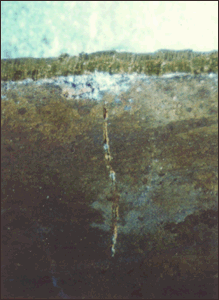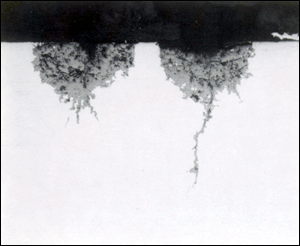
 |
What's the cure? A tightly written valve specification that limits brass alloys to those containing no more than 15% zinc, or specification of proven dezincification-resistant yellow brass alloys, say the experts. Further, manufacturers must be required to provide alloy designations or chemistry for the materials used in their valves and fittings. Over the past decade, an evolution in alloys has occurred, and yellow brasses that are dezincification-resistant do exist. However, specifiers who simply accept inexpensive yellow brasses without regard to whether they are standard alloys-or even meet the performance requirements of standard alloys-are vulnerable to potential dezincification problems.

Tube ID, 10X (courtesy)
Two types of corrosive attack characterize dezincification:
Plug-type dezincification is localized within surrounding surfaces mostly unaffected by corrosion. This type of dezincification penetrates deeply into the sidewalls of valves and fittings. Common failures associated with plug-type attack include penetration through the sidewalls that causes water seepage or loss of mechanical strength in threaded sections to the point of fracture.
Uniform-layer dezincification leaches zinc from a broad area of the surface. This type of dezincification uniformly reduces the wall thickness of the valve or fitting. A complex set of conditions must be present for dezincification to occur, and the occurrence is often related to region of the country.
The service conditions generally present where dezincification occurs include:
Water with high levels of oxygen and carbon dioxide (uniform attack).
Stagnant or slow moving waters (uniform attack).
Slightly acidic water, low in salt content and at room temperature (uniform attack).
Soft, low pH and low mineral water combined with oxygen, which forms zinc oxide (uniform attack).
Waters with high chloride ion content (uniform attack).
Neutral or alkaline waters, high in salt content and at or above room temperature (plug-type attack).
Common signs that dezincification is occurring include:
Presence of a loosely adhering white deposit of zinc oxide on the exterior of the valve.
Presence of mineral stains on the outer surface of the valve.
Water weeping from the valve body or stem/bonnet seal.